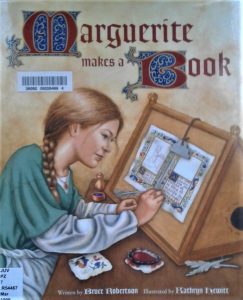
by Bruce Robertson
Once again I get to teach a group of children something of the history of ancient manuscripts and the art of illumination. In my review of The Ink Garden of Brother Theophane, I noted that my favorite resource for the subject is Marguerite Makes a Book. Robertson’s story outlines the process of making a book in the 1400s. The amount of information is just right for the age group I’ve typically introduced to the topic; third through sixth graders. Kathryn Hewitt’s enticingly detailed, winsome illustrations are lessons in themselves.
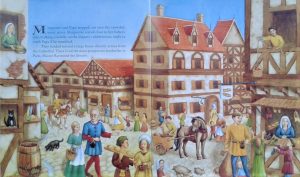
I don’t love this book for the story. Robertson resorts to the device of putting a child in the position of having to save her parents. Marguerite’s father, Papa Jacques, is the most famous book painter in Paris. But he is getting old and shaky, and his eyesight is failing. What will the family do if he isn’t able to complete the prayer book he’s working on for the wealthy and important Lady Isabelle? Well, Marguerite will have to do it for him!
We learn, when Marguerite goes with her father to the libraire to get the parchment pages on which a scribe has written the prayers for the book, that Papa Jacques doesn’t do the writing. While there, he also buys gold leaf and powdered gold. As they are leaving, Papa Jacques is knocked down by a careening wagon and his glasses get broken. Marguerite gets Papa home, puts him to bed, and sets out to finish Papa’s project.
Marguerite has to begin by obtaining all the elements of a book. First she goes to the man who prepares parchment, and we see calf skins stretched on frames and being scraped. From there, she goes to the market for goose feathers for pens, and eggs for mixing paints. Then, on to the apothecary, where she buys various ingredients for different colors of paint.
Back home, she gets to work.
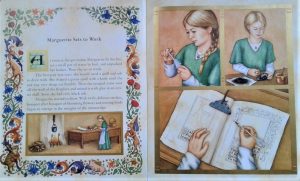
Two fold-out pages give us a four-page spread illustrating how Marguerite makes her paints. She really knows her business!
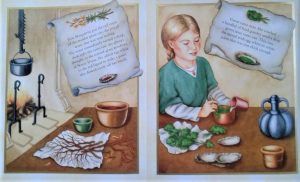
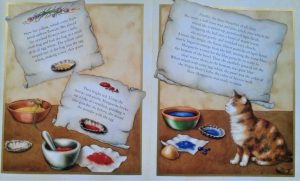
Just as she finishes, Lady Isabelle’s steward knocks at the door demanding the book. Before Papa Jacques can explain that it isn’t ready, Lady Isabelle sees the finished pages lying on his workbench. She is, of course, delighted with the book.
And with that, Papa’s and Marguerite’s work was sold to the noble Lady Isabelle and Papa kept his reputation as the finest painter of illuminated manuscripts in all of Paris–with the finest apprentice.”
The story is followed by a glossary of the technical terms used in the book, and an author’s note about the manuscripts that inspired him.
Brother Theophane’s vines, berries, leaves, and flowers are quite appealing to me, and the margins are full of excellent examples of variations of Celtic knots. The swirls and vines of Brother Hugo are riotously imaginative, and the story is told with good humor. But if I had to choose one picture book as a resource on the subject of manuscripts and illumination, I would choose Marguerite. There are more details of the process, in words and pictures, than in the other two books. I appreciate the pages on which the artist has left parts of the designs unfinished so we can see what needs to be done. The illustrations of 15th century daily life alone make a wonderful jumping-off place for further study of the times.
However, I hope that if you decide to study the subject, you won’t have to choose just one book!
To learn more about this book, go to biblioguides.com.